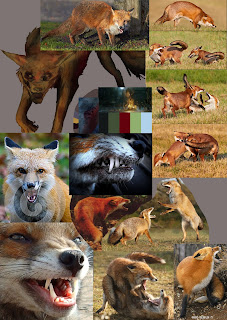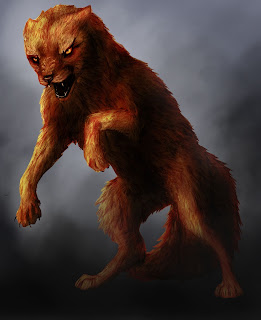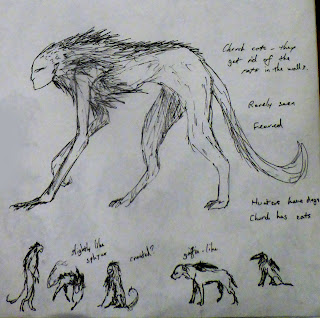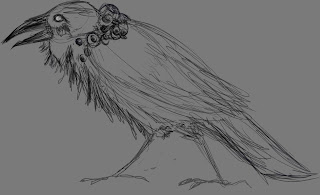I didn't have access to my camera for a while so I couldn't update my blog with images, but now I can rectify that. I have also added my brushpen sketches to
this blog post from earlier.
Bloodborne - Creature Design Mini-Project
Initial sketches, toying with a bull, fox, crow, and cat creature.
Pencil - looking at werewolves.
Pencil - exploring the idea of a human-like mimic creature, which wore the skin of another enemy and burst out when attacked. Would be much stronger than a typical version of that enemy.
Foxes. Tested the potential of having a crown-like crest of horns. Also looked at how foxes hunted, and how they might pounce on crows in-game.
Pencil - hunter wearing a wolf-skin, and a crow beak forcing its way out of a human's mouth.
Pen - werewolves, foxes, hounds, also the idea of an existing, recognisable weapon in the game being buried in the body of a strong enemy to add more depth to the world, implying another hunter fought it and lost.
Outliner pen - Yatagarasu (three-legged crow), snake ball variant with a crow host, muzzled werewolf with hunter master.
Outliner pen - werewolves, foxes, cats. Cats are burnt and ragged - potentially blind the area around them with thick smoke emanating from their bodies.
Brushpen - tested drybrush method with less ink. It gives a good sense of depth and form. Looked at horses (one saddled), Yatagarasu, and looked at some crow references.
Brushpen - playing with layout of sketches. Looked at bandages, blindfolds and trapdoor spiders.
Sepia outliner pen - trapdoor spiders studies. The ravine trapdoor spider has a curious body shape with patterning on the back - this could be utilised in the game as a face/skull of the original transformed human, or a rune that casts magic.
Pentel brushpen - crow/raven studies.
Close-up of text in prior image. Looked at Yatagarasu, Sanzuwu and Samjok-o for inspiration/behaviour for my three-legged crow.
Brushpen - human studies - copied a pose and looked at how it might become a creature. Looked more at crows (blind, or made of corpses), foxes, and the muzzled werewolf and owner.
Purple gel-pen/sepia outliner - breaking up black images with colour.
Brushpen- three-winged crows, claw beaks and antlers. Broke into a more stylised artstyle in the middle.
Outliner pen - crow/fox hybrid. Hounds. Human hunter with face-covering mask.
Outliner pen - horses. Considering a unicorn-inspired warhorse that managed to survive in Bloodborne's bleak landscape. The wolves bled into more chimeric monsters, featuring absorbed souls screaming in their flesh. Also looked at rat chimeras and rat kings.
Pen - Chimeric crows, wolves.
Pencil - wolf made of corpses, chimeras, wolf with backwards human arms (unsettling gait?), fox in a cow skull, and a crow-headed dog Cerberus-inspired chimera.
Pencil - human with flayed arm-skin, forming wings. Crow with a ring through its skull. Wolf with no lower jaw. Crow-human hybrid.
Outliner pen (black/blue) - Wolves with snakes/horns. Considered a bear. Muzzled wolf.
Outliner pen - hyena-inspired hound, large jaws.
Waterbrush filled with ink - Crow, several silhouettes. Much wetter than expected, hard to detail with, might be better with different ink or a dip-pen.
Brushpen (various) - silhouettes. Testing proficiency of pens more than paying attention to sketches, meaning I created a variety of odd monsters to be inspired by.
Brushpen (various) - silhouettes. Again testing pens. Decided the 'Pentel pocket brushpen for caligraphy' is excellent for blocking in silhouettes and not fussing over details.
Pencil/outliner - sketches in Natalie Hall's artstyle. She often constrains creatures to shapes, so they are bent in unnatural lines, but it was an extremely fun exercise and caused new ideas due to the constraints of the perceived box. I also added some shadows with brushpen, trying Andrew Mar's artstyle. I will attempt his artstyle more as it focuses on more complex lines with well-placed shadows, and might offer new insight into the design process.
Digital - Foxes, various poses.
Moodboard for previous sketches, early colour test on a chosen pose using Mike Corriero's colour swatch technique.
Took a creature from the pages of my sketchbook and developed its pose more than I normally would. Looking at its form, how its head looks from various angles.
Completed one pose in colour using the swatches again from earlier. Crow-headed Cerberus dog.
Picked another pose, began working on it - crow developing eyeballs around its neck.
Various digital sketches based on gathered ideas from my sketchbook. The wolf has dead/dying crows impaled on its spikes that would attack the player also.
Self-Reflection
- Tested: Mike Corriero, drybrush, ink-filled waterbrush, Natalie Hall, Andrew Mar.
- Getting more proficient with brushpens - can confidently test more artstyles with them now.
- Keep trying other artists' styles - possibly redraw a finalised creature in another artstyle to compare their overall effect.
- Try adding colour - look into Peter Han's style for brushpen and watercolour ideas.
- Use Feng Zhu's method for designing a few creatures (normal as according to design brief, more outrageous, completely own ideas).
- Do seperate headshots for a couple of creatures, like the DmC artbook's design process.
I'm going to pick out at least ten creatures from my initial designs and illustrate them digitally, and possibly redo a few in various artstyles/mediums for comparison. I will also break apart each design to explain why they are as they are (within the perceived game lore, and my own design choices), and what I've learnt from each new design process.






































